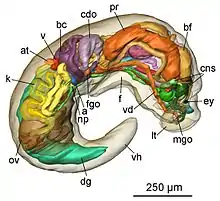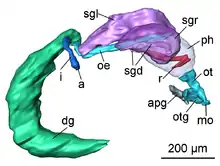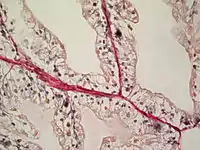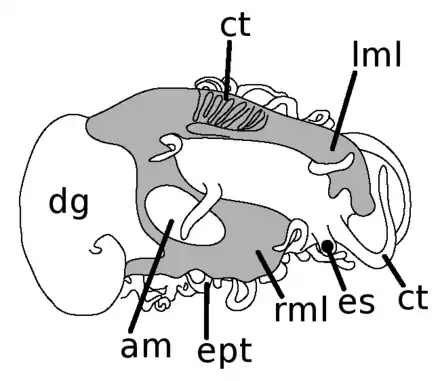Hepatopancreas
The hepatopancreas, digestive gland or midgut gland is an organ of the digestive tract of arthropods and molluscs. It provides the functions which in mammals are provided separately by the liver and pancreas, including the production of digestive enzymes, and absorption of digested food.[2]

Arthropods
Arthropods, especially detritivores in the Order Isopoda, Suborder Oniscidea (woodlice), have been shown to be able to store heavy metals in their hepatopancreas.[3] This could lead to bioaccumulation through the food chain and implications for food web destruction, if the accumulation gets high enough in polluted areas; for example, high metal concentrations are seen in spiders of the genus Dysdera which feed on woodlice, including their hepatopancreas, the major metal storage organ of isopods in polluted sites.[4]
Molluscs




The hepatopancreas is a centre for lipid metabolism and for storage of lipids in gastropods.[6]
Some species in the genus Phyllodesmium contains active zooxanthellae of the genus Symbiodinium in the hepatopancreas.[7]
See also
References
- Daniel J. Jackson; Carmel McDougall; Kathryn Green; Fiona Simpson; Gert Wörheide; Bernard M Degnan (2006). "A rapidly evolving secretome builds and patterns a sea shell". BMC Biology. 4: 40. doi:10.1186/1741-7007-4-40. PMC 1676022. PMID 17121673.
- http://web.vims.edu/adv/ed/crab/guts3.html
- Claus Svendsen; Graeme Paton; Jason M. Weeks (2002). "Soil biomarkers (invertebrates and microbes) for assessing site toxicity". In G. I. Sunahara; A. Y. Renoux; C. Thellen; C. L. Gaudet; A. Pilon (eds.). Environmental Analysis of Contaminated Sites. John Wiley and Sons. pp. 95–134. ISBN 978-0-471-98669-0.
- S. P. Hopkin; M. H. Martin (1985). "Assimilation of zinc, cadmium, lead, copper and iron by the spider Dysdera crocata, a predator of woodlice" (PDF). Bulletin of Environmental Contamination and Toxicology. 34: 183–187. doi:10.1007/bf01609722. PMID 3978257. Archived from the original (PDF) on 2011-07-22.
- Maeda T., Hirose E., Chikaraishi Y., Kawato M., Takishita K. et al. (2012). "Algivore or Phototroph? Plakobranchus ocellatus (Gastropoda) Continuously Acquires Kleptoplasts and Nutrition from Multiple Algal Species in Nature". PLoS ONE 7(7): e42024. doi:10.1371/journal.pone.0042024
- Böer M., Graeve M. & Kattner G. (2006). "Exceptional long-term starvation ability and sites of lipid storage of the Arctic pteropod Clione limacina". Polar Biology 30(5): 571-580. doi:10.1007/s00300-006-0214-6.
- Ingo Burghardt; Heike Wägele (2004). "A new solar powered species of the genus Phyllodesmium Ehrenberg, 1831 (Mollusca: Nudibranchia: Aeolidoidea) from Indonesia with analysis of its photosynthetic activity and notes on biology" (PDF). Zootaxa. 596: 1–18.



